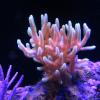-
Posts
170 -
Joined
-
Last visited
-
Days Won
3
Content Type
Profiles
Forums
Gallery
Everything posted by blusafe
-

Help ID this growing on my LR
blusafe replied to kohanson's topic in New to the Marine Aquaria Hobby
You can cut them out with a knife/scalpel. Anything used to kill Aiptasia can also kill these. They have a powerful sting that corals can not tolerate. -
sea squirt +2! Beneficial filter feeders.
-

Please help ID this - Anemone?
blusafe replied to Martian's topic in New to the Marine Aquaria Hobby
Be careful with knife because the little anemone bits may float around and grow to become separate adults. Chemical solutions are good, biological methods are also good (peppermint shrimp, fish, Berghia). Definitely Majano, not BTA. I had some green ones and killed them all. I regretted doing this because they were actually quite beautiful. Majano do not reproduce as quickly as Aiptasia (actually, I've never seen any reproduce past the small rock they were on), and the sting is not as powerful. Keeping the thing alive is an option if you can manage its care. -

Tiny "feather dusters" growing on zoa
blusafe replied to cly2012's topic in Disease treatment/parasite/pest control
I have those ALL OVER my tank on EVERY SURFACE. Sump, overflow, pipes, rocks, etc etc. They are not harming your corals - something else is causing them to close. If they were irritating the zoas, then only the immediate polyps should be closed. -

Aiptasia anemones with hot water
blusafe replied to rainmalawi's topic in Disease treatment/parasite/pest control
Bergia nudibranch eat Aiptasia. http://www.saltyunderground.com/pages.php?pID=23 -

Cure for Ich/Parasite
blusafe replied to nakazoru's topic in Disease treatment/parasite/pest control
In my humble experience...bucket/tank transfer, combine with fallow period if your display is infested, is the best method for removing ich. The best tool against ich is to intimately understand the parasite's life cycle (see links below). Once you read and absorb knowledge, you will understand why the disease frustrates. The standard novice mistake is to think ich has been eradicated when the fish no longer have spots. Not true, this is part of the normal life cycle when cysts fall off to produce daughter parasites. If you really want to eradicate the bug then you have to put in hard work and patience. Ich is not killed by any miracle potion, food, or other quick fix. Be prepared to put in long weeks or just live with the disease. Tank/Bucket transfer http://www.reefcentral.com/forums/blog.php?b=508 Quick pros/cons of each method discussed so far: PROVEN EFFECTIVE (assuming user is following proper and clean procedure): Copper - 100% effective. Inverts and some fish cannot tolerate. Precision required. Must use in sterile set-up (no rock or filter media). Not recommended for beginners. Hypo - 100% effective. Inverts and some fish cannot tolerate. Precision required (wider margin of error than copper). Formalin - 100% effective. Inverts and some fish cannot tolerate. Toxic to humans. Hard to acquire. COINCIDENTAL, MARGINAL, POSSIBLE EFFECT UV - Hard to dial in for parasites. Not 100%. Expensive. Garlic and other special foods - Not 100%. Coincidental/anecdotal evidence. All other medicine - Nothing has been proven 100% effective against ich other than copper or formalin. PROVEN NOT EFFECTIVE Biological controls - Using fish has an obvious flaw - the cleaner will become infected! Cleaner shrimp cannot "dig" deep enough to remove encysted parasites. Not 100%. Freshwater dip/bath - Does not kill encysted stage of life cycle, only free-swimming in water column. As others have commented, you can dip/bath every few days, but this method has a serious flaw. What about the parasites in the holding tank? Also, a dip does not kill encysted parasites. Not 100%. My reference/resource: http://www.reefkeeping.com/issues/2003-08/sp/ http://www.reefkeeping.com/issues/2003-10/sp/feature/ -
Next time, you can try Hikari algae pellets. I have a blenny and yellow tang which loves them.
-
You can also try feeding nori seaweed
-
Ich burying into sand is a ridiculous concept...I haven't seen anything scientific supporting that assumption! The longest known marine ich cyst hatched after 72 days. So in this situation, if it was ich, then all the fish should have had a low infestation level until death. Ich is not a "sudden" killer. The fish should have many white spots before slowly succumbing to weakness and secondary infection. Not in three short days. The OP would definitely have noticed if ich killed the fish. I second the toxic gas hypothesis, probably hydrogen sulfide. Should notice a rotten egg smell. Enough H2S can kill an adult human with a single breath.
-
If they are paired for two years, then one should already be female.
-

problem in dissolving red sea coral pro salt..
blusafe replied to braincoral's topic in General Reefkeeping_
You MUST add SALT TO WATER, not WATER to SALT. This is extremely important. Adding water to salt causes a hypersaline condition, and pH spike. This will cause calcium carbonate to precipitate into white gooey flakes. Harmless, but irritating as sediment to livestock. Obviously, also depletes your calcium. I made this mistake once! -

EMERGENCY. SOS. Temporary home for fish.
blusafe replied to Kamil Tooshie's topic in General Reefkeeping_
I can host your corals with my quarantine tank. About 12 gallon, strong lighting and flow. Near Sembawang PSA. No charge. -
What are you trying to use the algae to feed? Need lots of nitrates, phosphate, and red spectrum lighting. Algae are easy...
-
The worm is not happy. Do the usual tests. Also, I stumbled upon this somewhere once but forgot where it came from. As worms age, they require larger food and grow larger crowns. Most home aquariums cannot supply large plankton foods so they shed their crowns and grow a new one. As long as the tube looks fine and plump - meaning the body is not decaying - the worm is alive. Leave it alone.
-
I agree..my maroon clown was eaten by my anemone..
-

The Aquarium - behind the scenes at the London Aquarium
blusafe replied to a topic in General Reefkeeping_
Amazing that they did all that in two weeks! That's my dream job - to work for a public aquarium. -

Study Suggests Overfishing of Sharks Is Harming Coral Reefs
blusafe replied to Harlequinmania's topic in General Reefkeeping_
One more point for FINished with Fins https://www.sharksavers.org/en/our-programs/i-m-finished-with-fins/ -
Shrimp-like sounds amphipods. More than just food fish (mandatory for finicky eaters). They scavenge micro-algae and detritus. Probably hitchhiked on live rock.
-

Pls help ID Crab. Good or bad?
blusafe replied to DottyClown's topic in New to the Marine Aquaria Hobby
My rule is...get rid of all crabs. They are voracious omnivores that devour anything they can get their hands on. That's just me. Only exception are harmless commensals. -
No algae equals no nitrate is a bad assumption. Algae probably not growing due to light change, they thrive on lower (red) spectrum. Will take time to reestablish. As other people have stated, you need a stable tank. How "slowly" are you increasing the lights? If none of the animals are rapidly dying, I would leave the lights as is, and increase gradually once a week only. Due to the different opinions here, both saying increase and decrease, I would aim for a stable tank and observe the animals closely. Also, your alkalinity and calcium appear low.
-
I saw no mention of leathers (Sarcophytan) or Sinularia? Those are indestructible.
-
That's why corals need dips and QT! MMMMM those delicious nudibranchs.
-
If you are new (like me), I do not recommend anemone hosts. I had 3 bubbletips and all died for various reasons. These are difficult creatures to care for. Read this first: www.carlosreef.com/?wpdmact=process&did=MS5ob3RsaW5r Also, here's prophylactic antibiotic procedure because they are prone to infections. I believe two of mine died due to infections. http://reefcentral.com/forums/showthread.php?t=2271385 I would try first hardy corals with long polyps. Clowns readily accept these as hosts.
-
Jenaellyn: If you have livestock in DT, they are eating the pods. You mentioned crabs. Downdraft no-pump, upstream, overflow refugium tank is best. The pump will shred macro-plankton like pods. But still a good option! That's my plan to boost plankton production.
-
So yesterday I was cleaning a quarantine tank. I accidentally sucked out a female mandarin dragonet. She stayed stuck in the siphon tube for almost two hours before I realized was missing... Anyone else ever do anything like this?


